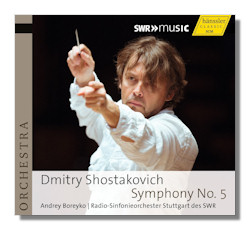
The Internet's Premier Classical Music Source
Related Links
- Shostakovich Reviews
- Latest Reviews
- More Reviews
-
By Composer
-
Collections
DVD & Blu-ray
Books
Concert Reviews
Articles/Interviews
Software
Audio
Search Amazon
Recommended Links
Site News
 CD Review
CD Review
Dmitri Shostakovich

Symphony #5 in D minor, Op. 47
Stuttgart Radio Symphony Orchestra/Andrey Boreyko
Recorded Live at Liederhalle Stuttgart Beethovensaal
Hänssler Classic 93.326 50m
Taken from live concerts on June 30 and July 1, 2011, in Stuttgart, Germany this performance strikes the listener as a somewhat understated but suavely played Shostakovich Fifth. The lower strings of the Stuttgart Radio Symphony Orchestra don't dig into the opening chords with all-out abandon, as one hears in so many other recordings. Rather, they play them firmly and emphatically, without a great sense of urgency or angst. The ending of the finale is also generally a bit restrained until the final crushing kettle and bass drum strokes. In between the temperament only occasionally rises to white-heat intensity, but when it does, it is most effective: try the tolling theme with strings and xylophone that climaxes the third movement. Having made these observations, one would likely expect my reaction to the recording to be rather tepid. Not so.
The Shostakovich Fifth is still the composer's most popular symphony, maybe his most popular work in any genre. Solomon Volkov's 1979 book Testimony changed the way many conductors interpret the work. To this day in fact, most conductors take the symphony's ending very slowly and very stiffly, in line with the Volkov claim that the ending represents forced celebration. I won't digress any further on Volkov, since I covered the issue of his book's authenticity in another review of the Shostakovich Fifth in 2005 (London Philharmonic SACD LPO0001). Suffice it to say that this symphony needs a less Mahlerian, less angst-centered approach to work effectively. Indeed, a performance should be more vital, more emotionally straightforward, qualities which Andrey Boreyko and the Stuttgart players handsomely provide. The orchestration is, after all, far less complex than in many other Shostakovich symphonies, and harmonies are relatively tame. The composer wrote the symphony, you'll remember, as "a Soviet artist's creative response to just criticism." Granted, the "criticism" wasn't just, but he had to pretend it was and he did so by toning down his expressive language. Still, there's plenty of drama and emotion in the work, and Boreyko and the Stuttgart players capture that drama and emotion in the proper portions, avoiding the temptation to go over-the-top. Thus, although the darker and deeper elements in this work aren't exactly slighted here, the Shostakovich of hidden-message fame seems to have yielded to Shostakovich the conformist with heart. In the end, despite mostly moderate to slow tempos, this performance must be assessed as both robust and vital, with accurate and spirited playing by the Stuttgart RSO under Boreyko, their principal guest conductor.
I would still favor the 1959 Bernstein recording on Sony or the 1965 Previn effort on RCA, but this new version by Boreyko, part of his ongoing cycle of Shostakovich symphonies, is one of the finest modern renditions of the work I have encountered. Its sound reproduction is excellent, especially considering its live concert origins. The only problem is that many will wonder why another work wasn't coupled with the symphony. With only fifty or so minutes on the disc, there was plenty of room for something more. Still, this is a fine achievement and Shostakovich mavens will want this disc, especially those following Boreyko's cycle. Thus far he has recorded symphonies #1, 4, 5, 6, 9 and 15 for Hänssler Classic, and generally to wide acclaim. Regrettably, I missed his earlier efforts in the series but now I anxiously await the further issues.
Copyright © 2014, Robert Cummings


















